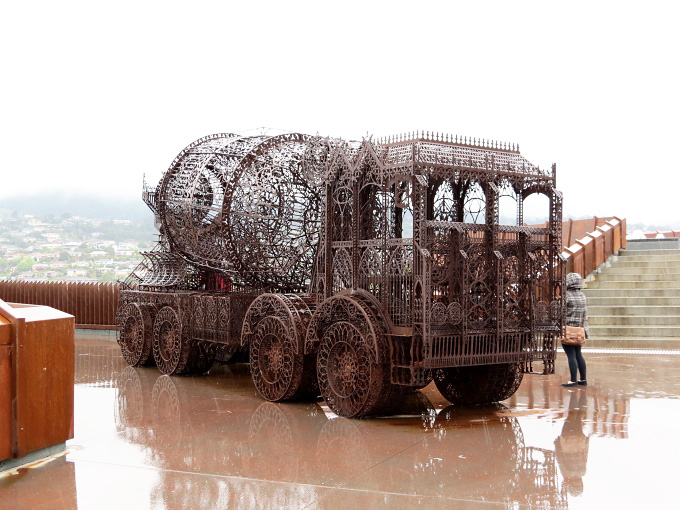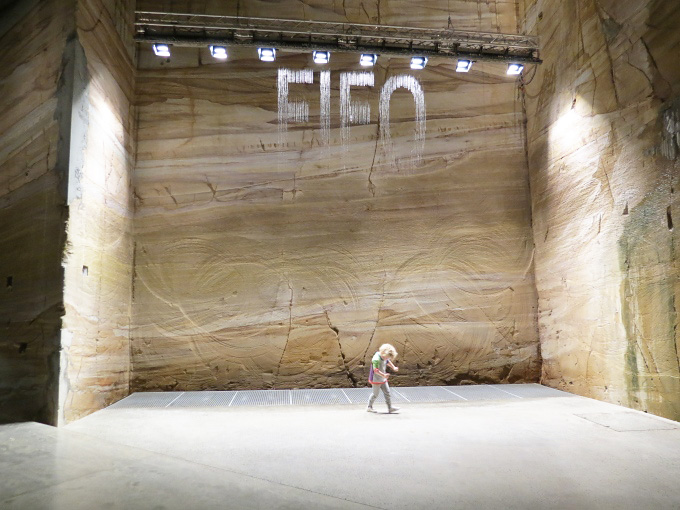Museum of Old and New Art - MONA
/ A very discriminating friend of ours said, “If MONA was in New York City, it would be rated one of the best museums in the world.”. With an endorsement like that, how could we miss it? The day was cold, raw and rainy as we headed north of Hobart in the marina courtesy van to the Museum of Old and New Art aka MONA.
MONA is the largest, privately-funded museum in Australia. It's owner, David Walsh, is a native Tasmanian whose career as a professional gambler has paid off in a big way. His penchant for collecting antiquities, modern and contemporary art led to the building of MONA to have a proper place to display his acquisitions and to share them with the world. He describes MONA as a "subversive adult Disneyland." When it opened The Age, Melbourne's daily newspaper, described it as “macabre and ungodly”. Lonely Planet compares it to the Guggenheim. Quadrant, an Australian intellectual magazine, described it as the art of a decaying society bereft of morality. Bizarre,unique, unusual, incredible… these are the words that come to my mind when I think of MONA. Also, superb, outstanding and extraordinary. Macabre, dark and disturbing fit in there somewhere, too.
A very discriminating friend of ours said, “If MONA was in New York City, it would be rated one of the best museums in the world.”. With an endorsement like that, how could we miss it? The day was cold, raw and rainy as we headed north of Hobart in the marina courtesy van to the Museum of Old and New Art aka MONA.
MONA is the largest, privately-funded museum in Australia. It's owner, David Walsh, is a native Tasmanian whose career as a professional gambler has paid off in a big way. His penchant for collecting antiquities, modern and contemporary art led to the building of MONA to have a proper place to display his acquisitions and to share them with the world. He describes MONA as a "subversive adult Disneyland." When it opened The Age, Melbourne's daily newspaper, described it as “macabre and ungodly”. Lonely Planet compares it to the Guggenheim. Quadrant, an Australian intellectual magazine, described it as the art of a decaying society bereft of morality. Bizarre,unique, unusual, incredible… these are the words that come to my mind when I think of MONA. Also, superb, outstanding and extraordinary. Macabre, dark and disturbing fit in there somewhere, too.
 We arrived at the unassuming mirrored entrance by walking first past by a winery, brewery and restaurant, then across a full-sized tennis court and a huge ornately sculpted, iron-rod cement truck. This was just the beginning of the surprises which awaited us inside. Those arriving by ferry up the Derwent River got a different view of the building, showing off its grandeur. The building itself, a three-level structure built into the cliffs of the Berriedale peninsula, is grand in the truest sense of the word … with large open spaces and great halls.
We arrived at the unassuming mirrored entrance by walking first past by a winery, brewery and restaurant, then across a full-sized tennis court and a huge ornately sculpted, iron-rod cement truck. This was just the beginning of the surprises which awaited us inside. Those arriving by ferry up the Derwent River got a different view of the building, showing off its grandeur. The building itself, a three-level structure built into the cliffs of the Berriedale peninsula, is grand in the truest sense of the word … with large open spaces and great halls.
We paid our admission and they gave us a headset and an iPod touch with instructions. We headed down a set of spiral stairs to the first level of exhibits. First of all, the “O” system is the guided tour which appears on your iPod screen. There are no labels, signs, maps or commentary in the museum exhibit areas. A touch of a button uses a geo-locator to figure out exactly where you are in the museum and tells you what exhibits are closest to you. You scroll down to find the exhibit you're interested in and voila...there it is.... a description of the piece. There's an “artwank” option which provides curatorial commentary on the piece; “ideas” which gives some food for thought and our favorite “Gonzo” which are humorous comments made by David Walsh. I could “hate” or “love” each exhibit if I wished with subsequent comments appearing as to how many other visitors agreed or disagreed with my vote. Sometimes there was audio to accompany the piece.
 The stairs going up and down and criss-crossing each other throughout the building were reminiscent of an M. C. Escher drawing. A maze of corridors led us past some wonderful and some outlandish pieces of art, begging the age-old questions: what is art? what is the role of art and the artist in society? We saw the mummy and coffin of Pausiris c.100 BCE. Only two people were allowed inside the Death Gallery at a time. Once inside the door, in a very dimly lit, black-walled room, we stepped on paving blocks surrounded by water which led to a pedestal where the coffin and mummy were most tastefully displayed. An x-ray machine showed the skeletal remains of the body. We saw several other mummies in the course of the day, but none so memorable.
The stairs going up and down and criss-crossing each other throughout the building were reminiscent of an M. C. Escher drawing. A maze of corridors led us past some wonderful and some outlandish pieces of art, begging the age-old questions: what is art? what is the role of art and the artist in society? We saw the mummy and coffin of Pausiris c.100 BCE. Only two people were allowed inside the Death Gallery at a time. Once inside the door, in a very dimly lit, black-walled room, we stepped on paving blocks surrounded by water which led to a pedestal where the coffin and mummy were most tastefully displayed. An x-ray machine showed the skeletal remains of the body. We saw several other mummies in the course of the day, but none so memorable.
 There was a skull comprised of beetle carapaces; a euthanasia machine; a kitten trophy rug (really!). The Snake by Sir Sydney Nolan is a 46m x 9m mural which took up one whole wall of a hall. Cloaca Professional is a machine that takes in food, digests it and renders excrement at the other end. It's said to be a commentary on the fact that modern art is crap. We're not sure. It was certainly bizarre.
There was a skull comprised of beetle carapaces; a euthanasia machine; a kitten trophy rug (really!). The Snake by Sir Sydney Nolan is a 46m x 9m mural which took up one whole wall of a hall. Cloaca Professional is a machine that takes in food, digests it and renders excrement at the other end. It's said to be a commentary on the fact that modern art is crap. We're not sure. It was certainly bizarre.
 There was an entire room of tapas, the ornately decorated bark cloth found in the South Pacific. One piece of artwork was called “Remnants of a suicide bomber cast in dark chocolate”. I especially appreciated a collection of intricate carvings and ornate masks from Papua New Guinea. Some pieces were erotic and sexual to the point of pornography. Every piece was evocative or provocative; for sure each elicited some response. “Artifact” was a huge metallic head laying on its side with windows so you could look inside it, strobe lights illuminating mechanical animations within.
There was an entire room of tapas, the ornately decorated bark cloth found in the South Pacific. One piece of artwork was called “Remnants of a suicide bomber cast in dark chocolate”. I especially appreciated a collection of intricate carvings and ornate masks from Papua New Guinea. Some pieces were erotic and sexual to the point of pornography. Every piece was evocative or provocative; for sure each elicited some response. “Artifact” was a huge metallic head laying on its side with windows so you could look inside it, strobe lights illuminating mechanical animations within.
 One exhibit took up an entire wall and extended up three stories. Entitled “bit.fall”, it was a digital cascade which displayed CNN-type headlines in jets of water, very cleverly symbolizing the flow of information. David was taken with “The Fat Car”, a bright red Porsche Carerra, fattened up and representative of the ultimate in consumer indulgence. The most disturbing exhibits were those in the Conflict exhibit which depicted art based on war. Men hung upside down with their genitals gouged out. Women screaming while being raped. Bloodied bodies strewn haphazardly on roadsides.
One exhibit took up an entire wall and extended up three stories. Entitled “bit.fall”, it was a digital cascade which displayed CNN-type headlines in jets of water, very cleverly symbolizing the flow of information. David was taken with “The Fat Car”, a bright red Porsche Carerra, fattened up and representative of the ultimate in consumer indulgence. The most disturbing exhibits were those in the Conflict exhibit which depicted art based on war. Men hung upside down with their genitals gouged out. Women screaming while being raped. Bloodied bodies strewn haphazardly on roadsides.
In all, over 400 artistic works are displayed. We spent the better part of the day there and could have spent longer. But it was not over when we left the museum. We had the option of saving our “O” tour which MONA sent to us within hours of our visit. It traced our steps through the museum in a 3-D format and provided the same information we had seen on the iPod. We can relive this visit over and over.






